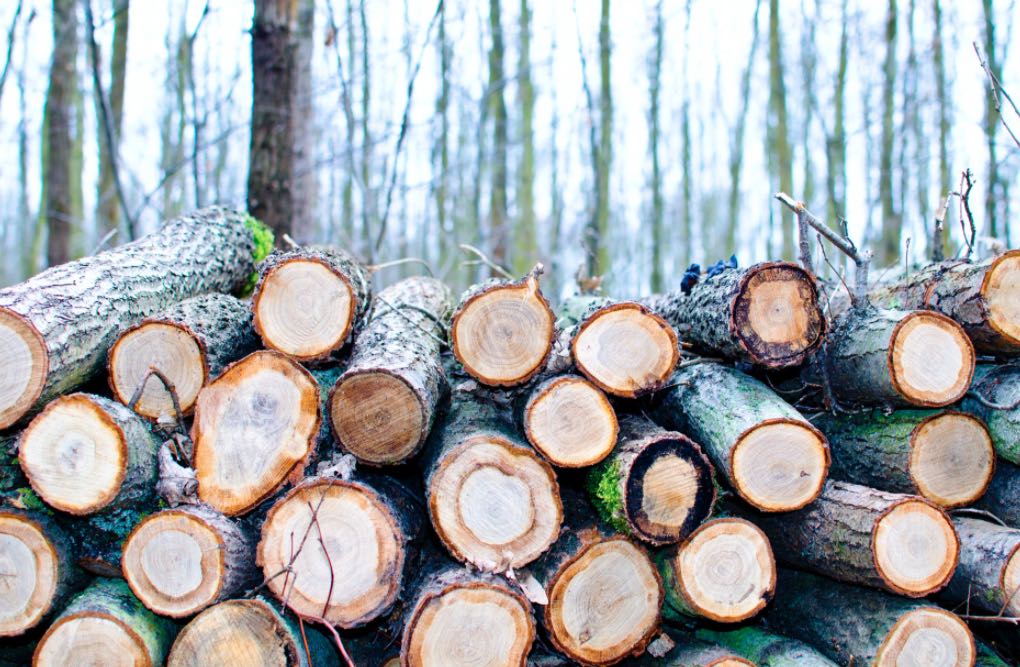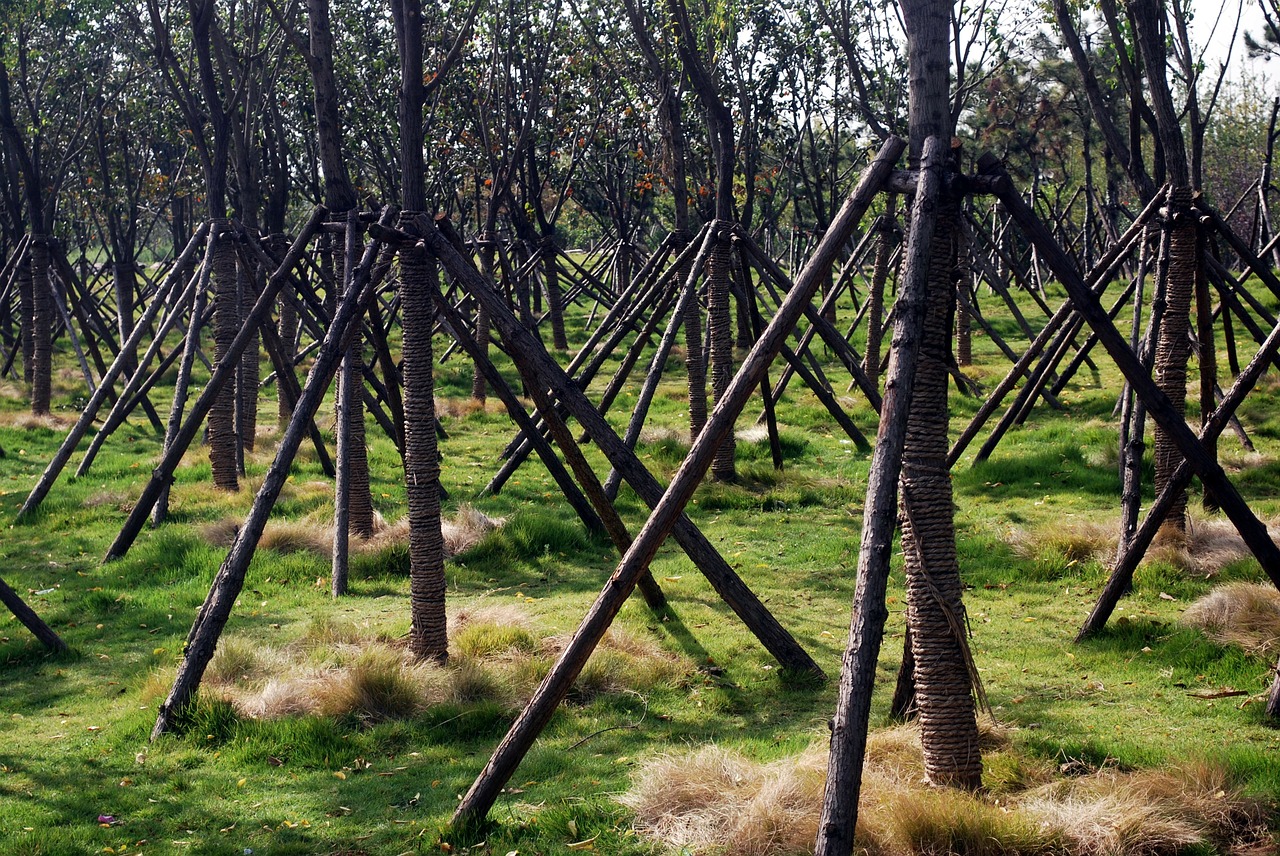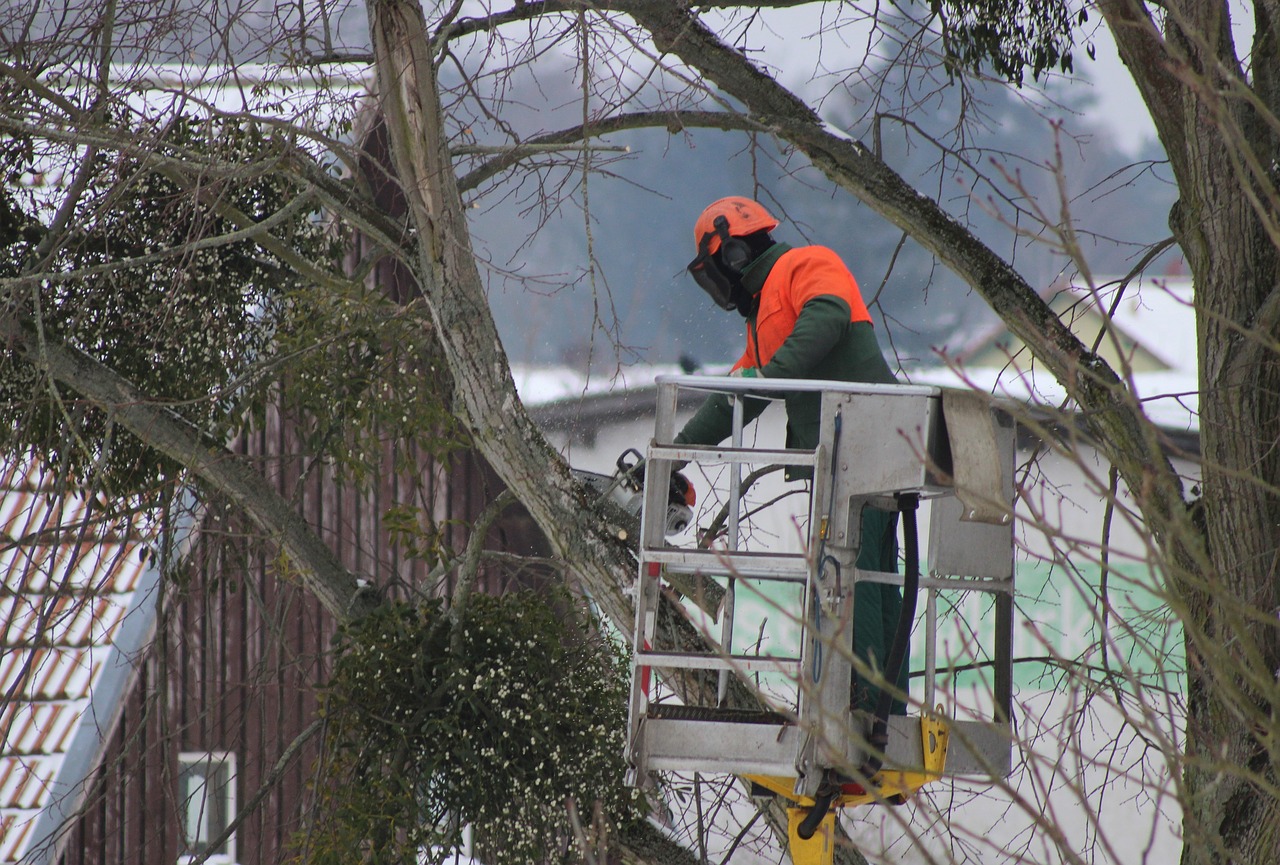The chore of felling massive trees on your property may appear insurmountable at first, but with the right equipment, you can complete the job with ease and safety. A tree in your garden may occasionally need to be removed. The number of branches it has will increase if its size is substantial. Master the art of tree felling by breaking the process down into simple, manageable steps, starting with the tree's lesser limbs and working your way up to its larger branches. We also provide you with a few helpful hints that will make cutting and cleaning up a breeze.
Branches and other flying debris could cause accidents, therefore you should clear the area around the work area. Put up a rope or some cones to block off the area, warn your loved ones not to approach near you while the power tools are running, and make sure they don't stand where any branches might fall.
Furthermore, proper protective gear is required. Prepare for working at height by donning a long-sleeved shirt, slacks, and jacket. Wearing safety glasses is mandatory, and using earplugs might protect your hearing from being damaged. Wearing protective gear such as a gloves, hard helmet, and a dust mask is mandatory whenever machinery is in use.
To Cut Down A Tree, What Can You Expect To Pay?
According to GoTreeQuotes, a service that provides access to arborists in your area, the average cost to remove a tree in Australia in 2019 is roughly $871. It also notes that this general pricing range is just an average, and that specific jobs may have a price tag anywhere from $350 to $4,500.
An arborist from Australian Tree Specialists named Eddie Jenner told Canstar that the price of tree removal is heavily influenced by where on your land the tree is located.
Adding to the price is "whether the tree is growing over something like a shed or the back of the home, or if it is close to service wires," they stated.
"Time is the primary factor; removing a tree from the front yard, for instance, will take less time than one from the backyard because of the reduced amount of hauling required. In most cases, labour costs will decrease as the closer the vehicle and machinery can get to the tree."
Experts, speaking from their experience, estimated that the expense to remove a tree of 25 feet (7.6 metres) in height and 1 foot (30 centimetres) in diameter at its base would be between $750 and $1,000. However, the price may be greater in some major cities. But they did say that homeowners that cut down a number of trees at once might be able to cut down on the overall expense of tree removal.
Does Cutting Down The Tree Really Need To Be Done?
Leaving the tree in place, if possible, is one of the best strategies to reduce the expense of removal. In some cases, a tree can be made less likely to cause a mess or block views by simply having some of its branches lopped off (a technique also known as tree lopping). It's best to consult an expert before deciding to cut down a tree.
- "I have suggested corrective trimming to clients who were planning to cut down gorgeous, large, old maple trees," they added.
- We can lessen the tree's risk to the house by cutting back its canopy, which will also lessen the mess it makes.
In Other Words, Get The Axe Ready!
When planning to cut down a tree, safety precautions and the avoidance of accidents should come first. Take note of the tree's context and the things that surround it. Trees and branches falling on homes, barns, power lines, fences, and other structures can cause costly repairs. Assume roads are located within the potential impact area; mark them accordingly. When starting off, it's best to have an expert help you fell trees if there are any nearby structures or other obstacles.
Watch out for other trees, too. A single tree's demise can have a domino effect on surrounding trees, especially if they are weaker or younger. It's best to think of every possible scenario before chopping down a tree, even if you don't believe the tree you're planning to cut down will strike an object.
Make Sure You Take Down That Tree Carefully
Put On Proper Protective Equipment
If you're going to be using chain saws or cutting trees, safety isn't a buzzword you can ignore. But it would help if you took it seriously. When working with a chain saw, and especially when cutting down a tree, there are some pieces of protective equipment that are required at all times: The most common source of injury for loggers is from branches falling on them. Protection for your ears and eyes: mufflers and a face shield. Protective eyewear to avoid inhaling dust. If you drop the bar and it hits your leg, your Kevlar chaps will stop the chain in its tracks.
Branches and other flying debris could cause accidents, therefore you should clear the area around the work area. Tell your loved ones they can't approach you while the power is on and make sure they're not standing in a spot where they could be hit by falling branches; then, cordon off the area with rope or cones.
Furthermore, proper protective gear is required. Prepare for working at height by donning a long-sleeved shirt, slacks, and jacket. Wearing safety glasses is mandatory, and using earplugs might protect your hearing from being damaged. Wearing protective gear such as gloves, a hard helmet, and a dust mask is mandatory whenever machinery is in use.
Choose A Cutting Path For A Tree
After getting a feel for your immediate surroundings, you can use the tree itself to determine the best approach for cutting down the tree. In the absence of obstacles, it may be preferable to fell a tree in the direction it is leaning naturally. Tree removal by a professional service may be necessary if it is leaning towards structures or other obstacles on the ground below. The direction a tree falls in is also affected by how fast the wind is blowing. Finally, think about the effort required to remove the tree once it has fallen and how easy or difficult it will be for you to access the region in the fall zone.
You would be surprised at how far down trees can reach. You can use the "axe handle trick" to roughly predict where a tree will fall when you're preparing to topple it. Here's how to fell a tree precisely where you want it:
- Stretch out your arm as though holding an axe.
- Just shut one eye.
- You need to either step away from the tree or step closer to it so that the axe's head is level with the tree's crown and the handle is level with the tree's base.
You want to plant your feet about where the treetop will land after it breaks. However, this is only a guess, so move everything the tree could potentially crush to a safer location.
Methods For Splitting Wooden Logs
The act of bringing down a tree often results in a large number of unwanted limbs that must be removed. Use a wood chipper to reduce any of these branches to mulch for your garden.
The log splitter is a very strong machine that can be used to make the larger pieces of the tree simpler to manage, but it should only be used by a trained professional. The local office can provide guidance on how to use this.
Cut Down All The Smaller Branches
Now that you can get to the heart of the tree, you should begin your trimming at the base and work your way up and out. Remove any dead or diseased branches with a pruning saw and loppers. In order to make the task of chopping down the larger branches easier, it is necessary to thin out the canopy first.
Create A Safe Slicing Area
Not until you know exactly which direction the tree will fall are you prepared to cut it down. Reduce the amount of undergrowth surrounding the tree and provide two escape routes on the "safe" side of the tree. They need to face in different directions, at an angle of around 45 degrees. A falling tree is a dangerous situation in which you definitely don't want to trip over anything.
The Components Of A Perfect Notch
The general rule of thumb for notch depth when felling a tree is to make it equal to one-fifth of the trunk's diameter. The angle requirements are depicted in the diagram, and must be met (or as close as you can). The tip of the notch should line up with the felling cut. The hinge will assist in directing the tree's fall in the appropriate direction as it begins to topple.
Disassembling The Boot
Once the tree's limbs have been chopped off, the trunk can be severed and the tree brought down in one piece. When cutting down a tree with a powerful chainsaw, it is best to start at the top and work your way down the tree if there isn't enough space for it to fall all at once on your land. Make a wedge cut in the tree's trunk to lop it. Make a second hinge incision exactly behind the tree, and it will tumble wedge-first in that direction.
Make Sure To Prune The Canopy's Upper Branches.
It's going to take a ladder to get to the upper levels of a particularly lofty tree. Be careful not to overshoot with your cutting, and keep the ladder steady. You are not trimming the tree, but rather cutting it down. You don't have to lop everything off, just thin off the foliage.
Dismantling A Tree By Eliminating Its Branches And Buttress Roots
Make sure you use your chainsaw to remove any little branches or buttresses that have grown onto the bottom portion of the tree trunk. Utilize a tugging cord to remove any unwanted tree limbs or branches. When making a cut, start at the top and work your way down, guiding the chainsaw blade along the bottom edge. Keep the tree trunk between you and the chainsaw by working at an angle. If you're using a chainsaw, never go beyond your shoulders to make a cut.
Chainsaw Larger Branches.
Use a chainsaw to lop off the major limbs. It's best to take things slowly, cutting off individual branches one at a time. Keep the last yard of the tree stump in situ so you have something to grab onto when you remove the stump.
There are certain differences between pruning and cutting huge branches, yet both tasks can serve similar purposes. Typically, this is a necessary task when a branch is dead or dying and poses a risk of falling onto your property. It is recommended to make three slashes when chopping down a sizable branch.
First, make a shallow cut about a metre or so away from where you ultimately want to severe the branch from the tree. To begin, make a cut about a quarter of the way through the branch, on the underside of the wood. This aids in the production of a smooth edge. Make a second, deeper cut further along the branch, this time cutting all the way through. Without causing any harm to the tree, this will remove a sizable chunk of the branch.
When making your third and final cut, you should do so at the joint between the branch and the trunk. By cutting off such a tiny piece of the branch, you're minimising the chance of illness and facilitating the tree's recovery. Hiring a crew of experts is the safest option when dealing with extremely enormous branches or those located at great heights.
Fallen Or Decomposing Trees
If you're cutting down a tree that you know is dead or decaying, be especially careful. If you don't know what you're doing with a chainsaw, We highly recommend hiring a professional tree service. Rot may be present inside the tree trunk if it feels mushy, changed colour, or acts strangely. Trees that have been weakened by decay are inherently unstable and need a considerably larger hinge in order to collapse.
Tree Removal Permits?
State and local ordinances concerning tree cutting and the need for appropriate permissions might differ greatly from one another. Before you start cutting down trees, you should probably call the city hall and find out what rules apply.
Local governments may issue hefty fines to homeowners who cut down trees without the proper permits. A Sydney woman, for instance, made headlines in 2018 when she was fined $83,000 for illegally felling two native trees on her neighbor's property without first obtaining permission from the local government. You may need a permit to cut down a tree depending on the following factors:
- In some cases, a permission is not required to cut down a tree if its trunk is beneath a specific circumference or its height is under a certain threshold.
- The removal of a native tree, for instance, may necessitate a special permit.
- The tree's proximity to your home will determine whether or not you need a permission to cut it down. In locations prone to bushfires, this exception is sometimes enforced.
Keep in mind, nevertheless, that you should verify the precise restrictions that apply in your region.
Is It A Good Idea To Remove Trees Yourself?
Depending on the size and location of the tree, you may be able to cut it down on your own with the use of a chainsaw or manual saw and some basic safety equipment (gloves, goggles, etc.).
DIY tree cutting, while tempting, is not without its dangers. Chainsaws, for instance, are "possibly dangerous" and "may cause fatal or serious injuries especially if operated by untrained personnel," as stated by Safe Work Australia. Even if you have the proper training and safety gear, a falling branch or even the tree's main trunk could cause serious injury. It might crash into a power line, or it might come crashing down on your property, damaging a shed or a carport, for example.
Any damage caused to your home by a tree or branch that has fallen due to the storm may be covered by your homeowner's insurance, depending on the terms of your policy. However, you may not be compensated if the damage was the result of an attempted tree removal that backfired.
Conclusion
In 2019, in Australia, the average price to have a tree cut down is around $871. The cost of a particular task could range from $350 to $4.5k. The distance of the tree from the road and its location on your property are two major factors in determining the final price. It would cost between $750 and $1,000 to cut down a tree that is 25 feet (7.6 metres) tall and 1 foot (30 centimetres) in diameter at the trunk's base. Homeowners who take down several trees at once may be able to save money, say experts.
Using chain saws or chopping down trees requires considerable attention to safety precautions. To avoid injury, wear protective gear including gloves, a hard hat, and a face mask made for dust. Whenever you're about to topple a tree, you can have a good idea of where it'll fall by using the axe handle method. You should back up until the axe's head is parallel to the tree's trunk. Get everything that could get crushed under the tree out of the way.
Construct two exits at a 45-degree angle from the "safe" side of the tree. The tree's fall will be more controlled thanks to the hinge. A chainsaw felling is like pruning an actual tree. The key distinction is that you are not simply chopping the tree down to size. When the tree's branches are removed, the trunk can be cut and the tree taken down in one piece.
We advise getting in touch with a professional tree service if you don't know how to operate a chainsaw safely. If you need to remove exceptionally large or high-up branches, it's best to hire a professional staff to do it. Homeowners who remove trees without a permit may face severe penalties from their local governments. Depending on the tree's location and size, you may be required to obtain a permit before you may have it removed. If you have access to a chainsaw or manual saw, you may be able to do the cutting on your own. For instance, cutting down a native tree often requires a permit.
Content Summary
- Large trees on your property may seem impossible to cut down, but with the correct tools, you can get the job done quickly and safely.
- Sometimes you'll need to cut down a tree in your yard.
- Learn how to fell trees by dividing the job down into little, manageable chunks, starting with the tree's smaller branches and working your way up to the larger ones.
- If you want to prevent injuries, you should clear the space around your work area of any branches or other flying debris.
- Also, safety equipment must be worn at all times.
- Wear a long-sleeved shirt, pants, and a jacket in preparation for working at a height.
- Removing a tree that is 25 feet (7.6 metres) tall and 1 foot (30 centimetres) in diameter at the base is projected to cost between $750 and $1,000, according to experts based on their years of experience in the field.
- However, they did note that homeowners who took down multiple trees at once could be able to save money on the job.
- One of the easiest ways to cut down on the cost of removal is to leave the tree where it is.
- Before chopping down a tree, it's wise to get professional advice.
- Cutting back the tree's canopy will reduce the danger it poses to the house and the amount of debris it drops.
- Prioritizing safety and preventing mishaps should be at the forefront of anyone's mind when they set out to cut down a tree.
- Notice the surroundings of the tree and what you learn from them.
- Be wary of other trees as well.
- Safety is not a keyword you can disregard if you plan on utilising chain saws or chopping down trees.
- When using a chain saw, and especially when felling a tree, it is imperative that you always wear the following safety gear: Loggers are most frequently hurt when branches fall on them.
- Also, safety equipment must be worn at all times.
- After orienting yourself to your immediate surroundings, you can use the tree to plan your method of attack.
- The axe's head should be even with the tree's crown, and the handle should be even with the trunk. This can be achieved by moving away from or towards the tree, respectively.
- You should place your feet roughly where the shattered treetop will land.
- Mulch your garden with the mulch you make from shredding these branches with a wood chipper.
- Now that you have access to the tree's interior, you may start cutting from the trunk and work your way to the branches.
- The use of a pruning saw and loppers will help you get rid of any diseased or dead branches.
- It's easier to get reach the bigger branches when the canopy is thinner.
- It's not safe to cut down the tree until you know for sure which way it will fall.
- Get rid of the overgrowth around the tree and clear two paths away from it on the "safe" side.
- When determining the depth of a notch to use in a tree's felling, it is common practise to use a value equal to one-fifth of the trunk's diameter as a guide.
- The notch's pointer must meet the felling cut.
- As the tree begins to crumble, the hinge will help direct its fall in the desired direction.
- Disassembling The Heel
- In order to chop down the tree, a wedge cut must be made in its trunk.
- The tree is being cut down, not trimmed.
- Use a tugging string to cut down any trees that are blocking your path.
- Working at an angle will help you keep the tree trunk out of the way of the chainsaw.
- Larger Branches Should Be Chainsawn.
- Get out your chainsaw and cut off the main branches.
- Take your time and prune away branches one by one for the finest results.
- When cutting down a huge branch, it's best to do so in three separate slashes.
- Before you actually cut the branch off the tree, make a shallow cut about a metre or so away from where you plan to make the final cut.
- Begin by making an incision on the underside of the branch, about a fourth of the way through the wood.
- Continuing along the branch, make a second, more substantial cut, this time going all the way through.
- This will remove a substantial portion of the branch without affecting the tree in any way.
- The juncture between the branch and the trunk is where you want to make your third and final cut.
- If you trim off just a tiny section of the branch, you can help the tree recover from any potential illness.
- Take extra precautions if you plan on down a dead or decaying tree.
- We advise getting in touch with a professional tree service if you don't know what you're doing with a chainsaw.
- Tree cutting laws and permits required by various jurisdictions can vary widely from one another.
- There may be regulations about tree removal that you need to check with the city hall about before you begin.
- Homeowners who remove trees without a permit may face severe penalties from their local governments.
- As an example, in 2018, a Sydney woman made news when she was fined $83,000 for cutting down two native trees on her neighbor's land without permission.
FAQs About Cutting Trees
Types of trees that require no approval. Camphor laurel (Cinnamomum camphora), Chinese nettle (Celtis sinensis), American nettle (Celtis occidentalis), coral tree (Erythrina x sykesii) and liquidambar (Liquidambar styraciflua) are all tree species which may be cut down or pruned without getting a permit from the City.
Whenever possible, stand on the uphill side of the tree. Work from the left side of the trunk (as you face toward the top of the tree). This allows the safest and most efficient use of the chain saw because you can rest the side or bottom of the saw on the trunk and slice off the branches with a pivoting motion.
You have the right to cut back any branches, leaves, or roots that cross your property boundary line at your own cost. This is known as the 'right of abatement'. If you rent your home, contact your property manager if you have an issue with a neighbour's tree.
Don't Attempt Cutting Down a Rotten Tree. Leave rotten trees to the pros. If the heart of the tree is rotted out, the felling direction can be extremely unpredictable. In addition, it most likely has many dead limbs above that just might shake loose and land on you during cutting.
The ecological balance will get disturbed, resulting in more frequent floods and droughts. The topmost fertile layer will be lost, resulting in reduced fertility and desertification with time. Wildlife will be affected, as the natural habitat provides shelter, food, and protection.





